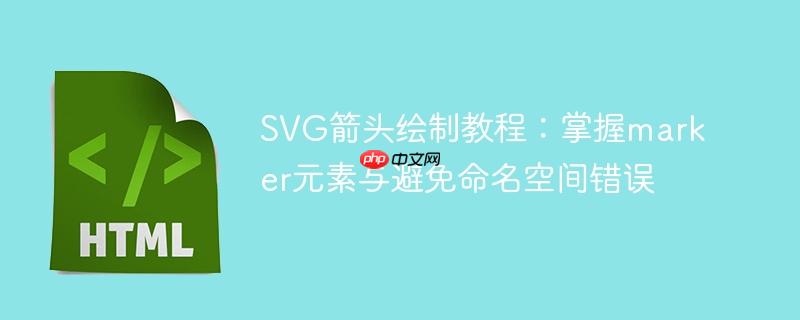
在svg中,marker元素用于定义可以在line、path、polyline和polygon等形状的起点、中点或终点重复使用的图形,最常见的应用就是创建箭头。marker元素必须定义在svg的<defs>(定义)容器内部,这样它们就不会被直接渲染,而是作为可复用的资源存在。
一个典型的marker定义包含以下关键属性:
在JavaScript中动态创建SVG元素时,必须使用document.createElementNS()方法,并提供正确的命名空间URI。这是因为SVG元素属于XML命名空间,与标准的HTML元素不同。
错误的命名空间URI示例:
// 这是一个错误的示例,注意http后面是分号而不是冒号
var path = document.createElementNS("http;//www.w3.org/2000/svg", "path");上述代码中的错误在于http;,它将http://中的冒号错误地写成了分号。尽管这看起来只是一个小小的拼写错误,但其影响是巨大的:
正确的命名空间URI:
所有标准的SVG元素都应使用以下命名空间URI:
const SVG_NAMESPACE = "http://www.w3.org/2000/svg"; // 正确的创建方式 var path = document.createElementNS(SVG_NAMESPACE, "path");
确保在创建任何SVG元素(如svg、defs、marker、path、line等)时,都使用这个正确的命名空间URI。
下面是一个完整的HTML和JavaScript示例,演示如何动态创建一个SVG,并在其中定义一个箭头marker,然后将其应用到一条直线的末端。
<!DOCTYPE html>
<html lang="zh-CN">
<head>
<meta charset="UTF-8">
<meta name="viewport" content="width=device-width, initial-scale=1.0">
<title>SVG箭头绘制教程</title>
<style>
body {
font-family: Arial, sans-serif;
display: flex;
justify-content: center;
align-items: center;
min-height: 100vh;
background-color: #f0f0f0;
margin: 0;
}
svg {
border: 1px solid #ccc;
background-color: #fff;
}
</style>
</head>
<body>
<svg id="mySVG" width="400" height="200"></svg>
<script>
// 定义SVG命名空间常量,避免拼写错误
const SVG_NAMESPACE = "http://www.w3.org/2000/svg";
const currentSVG = document.getElementById("mySVG");
/**
* 动态创建SVG箭头定义
*/
function createArrowheadDefinition() {
// 创建 <defs> 元素
var defs = document.createElementNS(SVG_NAMESPACE, "defs");
// 创建 <marker> 元素
var marker = document.createElementNS(SVG_NAMESPACE, "marker");
marker.setAttributeNS(null, "id", "triangleArrow"); // 唯一ID
marker.setAttributeNS(null, "refX", 10); // 箭头的尖端在marker视口中的x坐标
marker.setAttributeNS(null, "refY", 5); // 箭头的尖端在marker视口中的y坐标
marker.setAttributeNS(null, "markerUnits", "strokeWidth"); // 标记大小随描边宽度缩放
marker.setAttributeNS(null, "markerWidth", 10); // marker视口宽度
marker.setAttributeNS(null, "markerHeight", 10); // marker视口高度
marker.setAttributeNS(null, "orient", "auto"); // 箭头方向自动适应线段
// 创建 <path> 元素来定义箭头形状
// "M 0 0 L 10 5 L 0 10 z" 绘制一个三角形 (0,0) -> (10,5) -> (0,10) -> (0,0)
var path = document.createElementNS(SVG_NAMESPACE, "path");
path.setAttributeNS(null, "d", "M 0 0 L 10 5 L 0 10 z");
path.setAttributeNS(null, "fill", "black"); // 填充颜色
path.setAttributeNS(null, "stroke", "none"); // 无边框
// 将path添加到marker中
marker.appendChild(path);
// 将marker添加到defs中
defs.appendChild(marker);
// 将defs添加到SVG根元素中
currentSVG.appendChild(defs);
}
/**
* 动态创建一条带箭头的直线
*/
function createLineWithArrowhead() {
// 创建 <line> 元素
var line = document.createElementNS(SVG_NAMESPACE, "line");
line.setAttributeNS(null, "x1", 50);
line.setAttributeNS(null, "y1", 100);
line.setAttributeNS(null, "x2", 350);
line.setAttributeNS(null, "y2", 100);
line.setAttributeNS(null, "stroke", "blue");
line.setAttributeNS(null, "stroke-width", 3);
// 引用之前定义的箭头marker,注意这里的URL写法
line.setAttributeNS(null, "marker-end", "url(#triangleArrow)");
// 将直线添加到SVG根元素中
currentSVG.appendChild(line);
}
// 页面加载完成后执行
document.addEventListener("DOMContentLoaded", () => {
createArrowheadDefinition(); // 先定义箭头
createLineWithArrowhead(); // 再创建带箭头的直线
});
</script>
</body>
</html>通过遵循上述步骤和调试技巧,您可以有效地在SVG中创建和管理箭头,并避免常见的渲染问题。
以上就是SVG箭头绘制教程:掌握marker元素与避免命名空间错误的详细内容,更多请关注php中文网其它相关文章!

每个人都需要一台速度更快、更稳定的 PC。随着时间的推移,垃圾文件、旧注册表数据和不必要的后台进程会占用资源并降低性能。幸运的是,许多工具可以让 Windows 保持平稳运行。

Copyright 2014-2025 https://www.php.cn/ All Rights Reserved | php.cn | 湘ICP备2023035733号